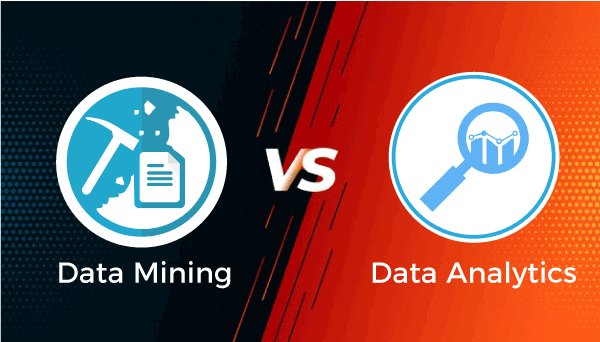Data Mining vs Data Analytics
In this digital era, no one can deny that data surrounded us from all corners. The current generation has been lucky enough to see the rise of the internet and all the advantages of free and accessible data sharing. Data mining and Data analytics are major steps in any business development (data-driven project). They are required to be done with better efficiency to ensure the success of the project. Data mining and data analytics are closely related, so making the difference between data mining and data analytics is quite difficult. Before proceeding towards the state to understand the difference between data mining and data analytics, first, we closely understand the two different fields separately.
What is Data Mining?
Data mining can be defined as the process of extracting data through finding patterns, cleaning, designing models and creating tests. It includes database management, machine learning and statistics concepts. Many business organizations use it to extract specific information from the database to find solutions to their business issues. Data Mining can transform raw data into useful information that can help achieve business goals.
Data Mining Concepts
Data mining tasks need various techniques, tools, and techniques. These are the given most significant concepts of data mining.
Data Cleaning:
In data cleaning, all the raw data taken from various sources are converted into a specific standard format that can be simply processed and analyzed. It incorporates identification and correction of errors, finding the missing values, removing duplicates, etc.
Artificial Intelligence:
Artificial intelligence systems perform analytical activities such as planning, learning, and problem-solving.
Association rule:
Association rule is also known as market basket analysis. It is an important concept for determining the relationship between different dataset variables.
Clustering:
Clustering refers to the process of splitting the huge set of data into smaller segments or subsets called clusters.
Classification:
This concept is used to assign categories to a data collection to get more analysis and prediction.
Data Analytics:
Once the useful information has been bought together and processed, data analytics is used to evaluate data, find patterns, and generate statistics.
Data Warehousing:
Data warehousing refers to the process of collecting and storing business data that helps in quick decision-making purposes.
Regression:
Regression is used to predict a range of numeric values, such as stock prices, sales, temperature based on the specific data set.
What is data analytics?
Data analytics is a process of evaluating data using analytical and logical concepts to examine a complete insight of all the employees, customers and business. In this process, the user data is extracted from raw data using specialized computer systems. These systems help in transforming, organizing and modelling the data to get output. It is a qualitative and quantitative process used to generate revenue and increase productivity. In this process, data is extracted and categorized according to the business needs. Data Analytics is widely used in various industries to enable organizations to make data-driven decisions.
Phases of data analytics
The various phases of data analytics are given below.
Discovery:
In this phase, analysts analyze the data and investigate the problem related to data to develop a context and understanding. This would help the analyst learn about the data sources required for the organisation’s specific project.
Data Preparation:
In this phase, the data analytics team prepares an analytics sandbox to accomplish the analytics process for the project’s duration. The analytics team requires performing various tasks such as extracting, transforming and updating data into these sandboxes.
Model Planning:
In this phase, the analytics team finds the process and techniques that it determines for the specific model building phase. The team analyses the data sets to learn about the relationships between variables and choose the most suitable models.
Model building:
In this phase, the analyst creates data sets for different purposes such as testing, production, and training.
Communicate results:
In this phase, the analyst interacts with stakeholders and finds if the outputs for the project are successful or failure.
Operationalize:
In this phase, the outcomes are delivered.
What does a business analyst do?
- Business analysts take care of business problems and make plans as per business requirements.
- The business analyst examines business requirements and prerequisites.
- Business analysts collaborate with the stakeholders keeping in mind that the end goal is to achieve the target.
- Business analysts are involved in the business frameworks.
Difference between Data Mining and Data Analytics

| Data Mining | Data Analytics |
|---|---|
| Data mining is a process of extracting useful information, patterns, and trends from raw data. | Data analytics is a process of evaluating data using analytical and logical concepts to examine a complete insight of all the employees, customers and business. |
| Data Mining is a step in the data analytics process. | Data Analytics is the umbrella that deals with every step involved in business purposes. |
| Data mining is performed on well-structured data. | Data Analytics can be performed on any data. |
| Data mining does not depend on any notions which are introduced before tacking the data. | It is mainly used for hypothesis testing. |
| It does not need any data visualizations such as bars, charts, etc. | It needs data visualization. |
